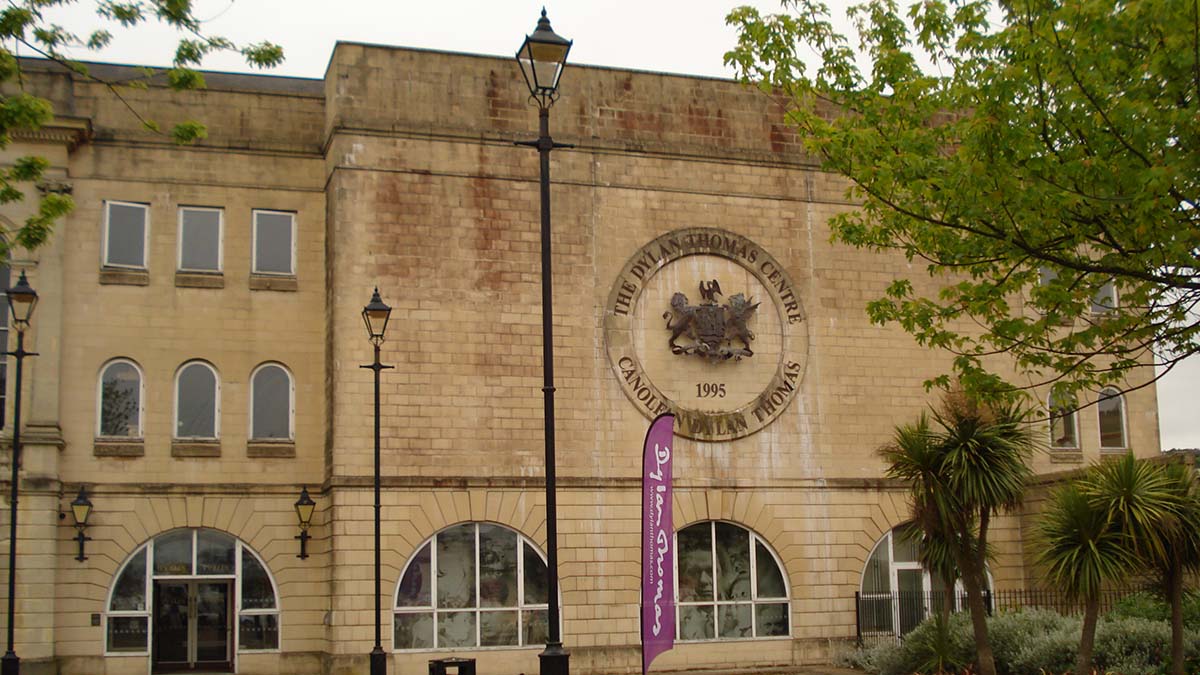
by W. Ruth Kozak
One Christmas was so much like another,
In those years around the sea-town corner now
And out of all sound except the distant speaking
Of the voices I sometimes hear a moment before sleep,
That I can never remember whether it snowed
For six days and six nights when I was twelve
Or whether it snowed for twelve days and
Twelve nights when I was six.
These precious words of Dylan Thomas are one of the best known and loved Christmas prose poems ever written. Born in Swansea, Wales in 1914, Dylan Thomas was Wales’ most beloved poets. He has been acknowledged as one of the most important Welsh poets of the 20th century.
 Included in his works are “Do not go gentle into that good night,” “Under Milk Wood” and “Portrait of a the Artist as a Young Dog.” Thomas began his career at the age of 16 as a journalist and many of his works appeared in print while he was still a teenager. Although he was appreciated as a one of the most popular poets of his time, he found living an earning as a writer difficult so he augmented his income with reading tours and radio broadcasts. In 1937 he married Caitlin Macnamara and lived for a time in the Welsh fishing village of Laugharne. Unfortunately, their relationship was destructive due to Thomas’s alcoholism.
Included in his works are “Do not go gentle into that good night,” “Under Milk Wood” and “Portrait of a the Artist as a Young Dog.” Thomas began his career at the age of 16 as a journalist and many of his works appeared in print while he was still a teenager. Although he was appreciated as a one of the most popular poets of his time, he found living an earning as a writer difficult so he augmented his income with reading tours and radio broadcasts. In 1937 he married Caitlin Macnamara and lived for a time in the Welsh fishing village of Laugharne. Unfortunately, their relationship was destructive due to Thomas’s alcoholism.
He recorded his famous work “A Child’s Christmas in Wales” while he was touring in the United States. It has been recorded since then by other famous Welsh actors including Richard Burton who was a great pal of the Thomas. Sadly, in 1953 during a trip to New York, Thomas collapsed outside a bar after downing a great quantity of whiskey and later died. His body was returned to Wales and buried in the village churchyard in Laugharne.
Coming from a Welsh back-ground, I’ve always been fascinated by Dylan Thomas writing, especially A Child’s Christmas in Wales. Every year I watch the video movie made of the famous poem. And on one of my trips to Wales I had the privilege of visiting Swansea and the Dylan Thomas Centre.
 The Dylan Thomas Centre is housed in a beautiful Regency building in Swansea’s Maritime Quarter. The centre hosts many literary and art programs. It was a thrill for me to wander the exhibits, all the while entertained by the rich Welsh tenor of Richard Burton reciting Thomas’s “Under Milk Wood”. The exhibits include bits of Dylan Thomas’ life including photos, hand-written notes and journals, news clips and other memorabilia. The Swansea Bay area has produced many other world-famous cultural icons such as actors Richard Burton, Catherin Zeta-Jones, and Anthony Hopkins. Burton was a personal friend of Thomas and there is a special display honoring their friendship.
The Dylan Thomas Centre is housed in a beautiful Regency building in Swansea’s Maritime Quarter. The centre hosts many literary and art programs. It was a thrill for me to wander the exhibits, all the while entertained by the rich Welsh tenor of Richard Burton reciting Thomas’s “Under Milk Wood”. The exhibits include bits of Dylan Thomas’ life including photos, hand-written notes and journals, news clips and other memorabilia. The Swansea Bay area has produced many other world-famous cultural icons such as actors Richard Burton, Catherin Zeta-Jones, and Anthony Hopkins. Burton was a personal friend of Thomas and there is a special display honoring their friendship.
Outside the Centre, facing the marina, is a life-size bronze statue of the poet, and not far away is the Dylan Thomas Theatre. The Swansea Little Theatre was the first Little Theatre in Wales. The group began performing from 1924. In the early ‘30’s Dylan Thomas became a member of the troupe and appeared with them in several plays over the next few years. The Swansea Little Theatre group moved to its present location in 1983.
If You Go:
About the author:
Ruth’s roots are in Caerphilly Wales and she visits there frequently. Ruth has been a travel writer and adventurer for many years, writing mostly about UK and Greece (her second home). As well as being the former editor/publisher of TRAVEL THRU HISTORY she’s on the staff of www.europeupclose.com and freelances to other on-line and print publications. Her historical fiction novel SHADOW OF THE LION will be published in August 2014 (first part: BLOOD ON THE MOON and second part THE FIELDS OF HADES 18 months later) by www.mediaaria-cdm.com. Ruth’s website has links to her writing at www.ruthkozak.com and there is a blog for the novel at http://shadowofthelion.com.
All Swansea photos by W. Ruth Kozak


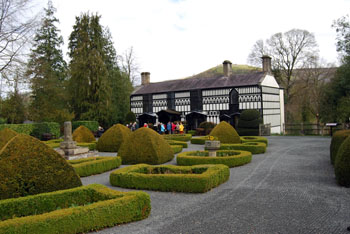
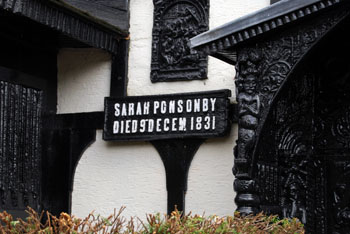 I’d heard the expression ‘Ladies of Llangollen’ before, but wasn’t sure in what context. A girls’ school, maybe? No, they were a pair of women who, back in the 19th Century, were famed far and wide … ‘celebrities’ of the day, if you like. Now, if the ‘Ladies of Llangollen’ lived in this day and age, they would probably be described as ‘offbeat’, eccentric or quirky. That is, if they were noticed at all, for nowadays, it’s accepted that women may take an interest in poetry, literature and politics, and two women living together would hardly raise an eyebrow.
I’d heard the expression ‘Ladies of Llangollen’ before, but wasn’t sure in what context. A girls’ school, maybe? No, they were a pair of women who, back in the 19th Century, were famed far and wide … ‘celebrities’ of the day, if you like. Now, if the ‘Ladies of Llangollen’ lived in this day and age, they would probably be described as ‘offbeat’, eccentric or quirky. That is, if they were noticed at all, for nowadays, it’s accepted that women may take an interest in poetry, literature and politics, and two women living together would hardly raise an eyebrow.
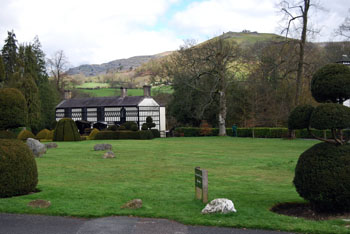
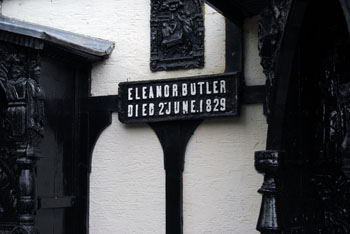 While they wished to lead a life of ‘ … sweet and delicious retirement’, their story attracted a great many visitors, who often stopped by on their way to Snowdonia or Ireland, and their fame rapidly spread. Their visitors included Robert Southey, Sir Walter Scott, Josiah Wedgewood Sir Humphrey Davy and the Duke of Wellington. William Wordsworth also came, and wrote a poem describing Plas Newydd as ‘ … a low roofed cot’ …’ which, reportedly, didn’t find much favour with the ladies, who declared they could write better poetry themselves.
While they wished to lead a life of ‘ … sweet and delicious retirement’, their story attracted a great many visitors, who often stopped by on their way to Snowdonia or Ireland, and their fame rapidly spread. Their visitors included Robert Southey, Sir Walter Scott, Josiah Wedgewood Sir Humphrey Davy and the Duke of Wellington. William Wordsworth also came, and wrote a poem describing Plas Newydd as ‘ … a low roofed cot’ …’ which, reportedly, didn’t find much favour with the ladies, who declared they could write better poetry themselves.
 The house is laid out pretty well as the ladies would have known it, with many memorabilia of their famed visitors. But, what most visitors notice above all is the intricate wood carvings, which the ladies collected, and embellished both the interior and the exterior of the house. ‘Low roofed cot’ it may have been originally, but their constant additions made it well worth the visiting. But, it’s not all down to the Ladies. After their deaths, subsequent owners added their own embellishments. The gardens, although started by the Ladies, owe their present form to a Mr G.H. Robertson, who lived there in the 1890s.
The house is laid out pretty well as the ladies would have known it, with many memorabilia of their famed visitors. But, what most visitors notice above all is the intricate wood carvings, which the ladies collected, and embellished both the interior and the exterior of the house. ‘Low roofed cot’ it may have been originally, but their constant additions made it well worth the visiting. But, it’s not all down to the Ladies. After their deaths, subsequent owners added their own embellishments. The gardens, although started by the Ladies, owe their present form to a Mr G.H. Robertson, who lived there in the 1890s.
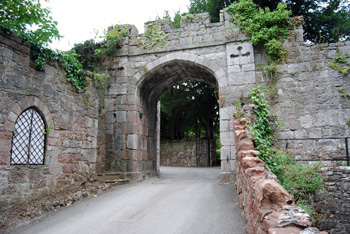
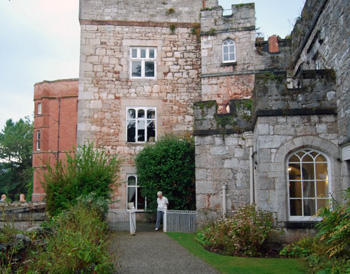 With that, he presented his infant son, born just a few days earlier.
With that, he presented his infant son, born just a few days earlier.
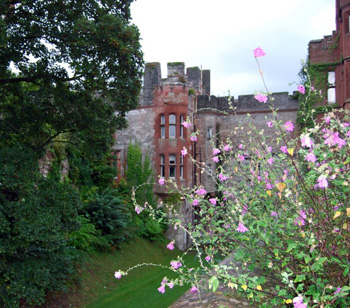 Ruthin Castle stands on a ridge overlooking the beautiful Vale of Clwyd. It was the castle that gave the town its name, for it’s a corruption of Welsh words meaning ‘red fort’, referring to the sandstone from which it was built. The castle, which Dafydd built in 1277, is in ruins now, destroyed in the reign of Charles II.
Ruthin Castle stands on a ridge overlooking the beautiful Vale of Clwyd. It was the castle that gave the town its name, for it’s a corruption of Welsh words meaning ‘red fort’, referring to the sandstone from which it was built. The castle, which Dafydd built in 1277, is in ruins now, destroyed in the reign of Charles II.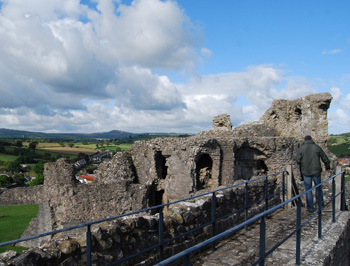 During this conflict, another of Dafydd’s strongholds fell. This was at nearby Denbigh. The current stone castle was built after the stronghold fell, as part of Edward’s ‘Iron Ring’ around North Wales. Henry de Lacy was commissioned by the King to build it, and was also granted a Borough Charter to establish the surrounding town of Denbigh … which also took its name from the castle; it’s a corruption of the Welsh for ‘little fort’.
During this conflict, another of Dafydd’s strongholds fell. This was at nearby Denbigh. The current stone castle was built after the stronghold fell, as part of Edward’s ‘Iron Ring’ around North Wales. Henry de Lacy was commissioned by the King to build it, and was also granted a Borough Charter to establish the surrounding town of Denbigh … which also took its name from the castle; it’s a corruption of the Welsh for ‘little fort’.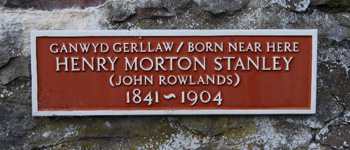 In the 15th Century, the castle was besieged twice, but held out, first, against the rebels of Owain Glyndwr then against the Lancastrians in the War of the Roses.
In the 15th Century, the castle was besieged twice, but held out, first, against the rebels of Owain Glyndwr then against the Lancastrians in the War of the Roses.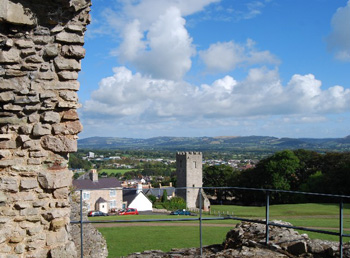 Ruthin Castle has connections with more modern Princes of Wales too. The ‘Prince of Wales’ suite and ‘Bertie’s Restaurant’ at the hotel are named after Albert Edward (later, of course, King Edward VII) who visited the house frequently in Victorian times … because he was having an affair with Patsy, the owner’s wife!
Ruthin Castle has connections with more modern Princes of Wales too. The ‘Prince of Wales’ suite and ‘Bertie’s Restaurant’ at the hotel are named after Albert Edward (later, of course, King Edward VII) who visited the house frequently in Victorian times … because he was having an affair with Patsy, the owner’s wife!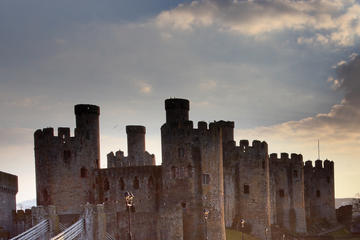
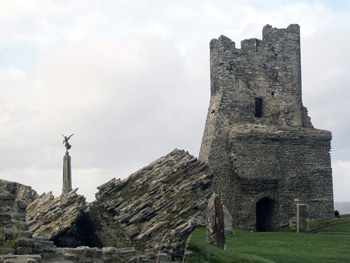
 Hinterland was the first network television series (a combined Fiction Factory production for Welsh language channel S4C and the BBC) filmed in Ceredigion; probably because its lack of motorways makes it difficult to reach for film crews. Its stark location was part of the appeal though, according to series producer Ed Talfan on the BBC Hinterland blog page:
Hinterland was the first network television series (a combined Fiction Factory production for Welsh language channel S4C and the BBC) filmed in Ceredigion; probably because its lack of motorways makes it difficult to reach for film crews. Its stark location was part of the appeal though, according to series producer Ed Talfan on the BBC Hinterland blog page: I wrote an article about the Cambrian line railway journey still available on what was Suite 101 years ago, and this year wrote a poem about a possible railway journey from Scarborough on Britain’s east coast to Aberystwyth on the west.
I wrote an article about the Cambrian line railway journey still available on what was Suite 101 years ago, and this year wrote a poem about a possible railway journey from Scarborough on Britain’s east coast to Aberystwyth on the west.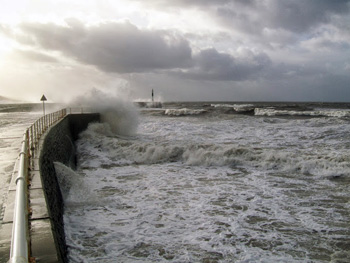 Circling the headland again, I saw the waves looked even higher as they crashed onto the south beach and defensive walls between the sea and harbour. So I walked down as far as I could, and was rewarded with excellent views and photos of the sun setting over the highest southern peak; between swirling grey clouds and above seawater flying high into the air after battering the promenade.
Circling the headland again, I saw the waves looked even higher as they crashed onto the south beach and defensive walls between the sea and harbour. So I walked down as far as I could, and was rewarded with excellent views and photos of the sun setting over the highest southern peak; between swirling grey clouds and above seawater flying high into the air after battering the promenade. A Welsh uprising against the rule of Henry IV under Owain Glyndwr captured the castle in 1404. He crowned himself Prince of Wales, and held a parliament at Machynlleth. Mach is a few stops on the trainline east of Aber, where the train can divide into two: one continuing east-west, and the other riding the south-north coast line to Pwllheli. The rebellion lost the castle in 1408, and order was restored under Henry V by 1415.
A Welsh uprising against the rule of Henry IV under Owain Glyndwr captured the castle in 1404. He crowned himself Prince of Wales, and held a parliament at Machynlleth. Mach is a few stops on the trainline east of Aber, where the train can divide into two: one continuing east-west, and the other riding the south-north coast line to Pwllheli. The rebellion lost the castle in 1408, and order was restored under Henry V by 1415. Aber town centre is quite small and easy to navigate. Walking out from the station the north beach is straight ahead past a pub sarcastically named after Lord Beechings. Lord Beeching’s report closed down the fifty-miles long Aberystwyth to Carmarthen train line linking mid and south Wales in 1965.
Aber town centre is quite small and easy to navigate. Walking out from the station the north beach is straight ahead past a pub sarcastically named after Lord Beechings. Lord Beeching’s report closed down the fifty-miles long Aberystwyth to Carmarthen train line linking mid and south Wales in 1965.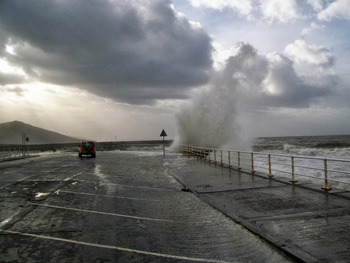 Under the bridges, the Mynach falls 300 feet in five steps to the Rheidol. The Devil’s Bridge name was inspired by a local legend that thought the original bridge was too difficult to build, so the Devil must have built it in exchange for the first soul that crossed. An old woman tricked the Devil by sending her dog onto the bridge. It’s a nice story, but a shame for her dog!
Under the bridges, the Mynach falls 300 feet in five steps to the Rheidol. The Devil’s Bridge name was inspired by a local legend that thought the original bridge was too difficult to build, so the Devil must have built it in exchange for the first soul that crossed. An old woman tricked the Devil by sending her dog onto the bridge. It’s a nice story, but a shame for her dog!

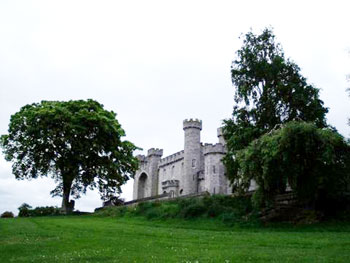 Even though Wales is famous for medieval castles, one such “mock” castle off the A55 motorway (a 30 minute drive from the Welsh border) is notable. It serves as an outpost for London’s National Portrait Galley: Bodelwyddan Castle. Bodelwyddan stands on land where property ownership purportedly goes back before the time of the Norman Conquest, and has recorded history dating from 1461, when the Humphreys family got this land as compensation for being booted off the Isle of Angelsey by Edward IV. From 1830-1850, the prominent Sir John Williams led the creating of an old time castle, including adding limestone walls, which actually were heated to protect the fruit orchards during cold weather.
Even though Wales is famous for medieval castles, one such “mock” castle off the A55 motorway (a 30 minute drive from the Welsh border) is notable. It serves as an outpost for London’s National Portrait Galley: Bodelwyddan Castle. Bodelwyddan stands on land where property ownership purportedly goes back before the time of the Norman Conquest, and has recorded history dating from 1461, when the Humphreys family got this land as compensation for being booted off the Isle of Angelsey by Edward IV. From 1830-1850, the prominent Sir John Williams led the creating of an old time castle, including adding limestone walls, which actually were heated to protect the fruit orchards during cold weather.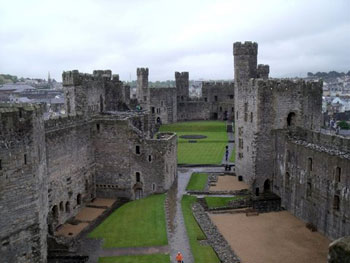 If you want to know just how hard life was for the common man back then, just visit a medieval fortress like Caernarfon Castle on a cold and rainy morning like I did. As I walked through its long passageways and explored the interior rooms whose walls are still intact some 700 years after being built, the chill and drafts went through my layered clothing to my bones. Much of the castle walls, both interior and exterior, remain intact from the time they were constructed between 1283-1330. After Edward I conquered Wales, he imagined a grand castle based on the dream of Roman emperor Magnus Maximus (whose body was found in the area). Maximus envisioned such a place located within a city amidst mountains and opposite an island (matching Caernarfon’s description), so James of Saint George was put in charge of building in this “dream city.”
If you want to know just how hard life was for the common man back then, just visit a medieval fortress like Caernarfon Castle on a cold and rainy morning like I did. As I walked through its long passageways and explored the interior rooms whose walls are still intact some 700 years after being built, the chill and drafts went through my layered clothing to my bones. Much of the castle walls, both interior and exterior, remain intact from the time they were constructed between 1283-1330. After Edward I conquered Wales, he imagined a grand castle based on the dream of Roman emperor Magnus Maximus (whose body was found in the area). Maximus envisioned such a place located within a city amidst mountains and opposite an island (matching Caernarfon’s description), so James of Saint George was put in charge of building in this “dream city.”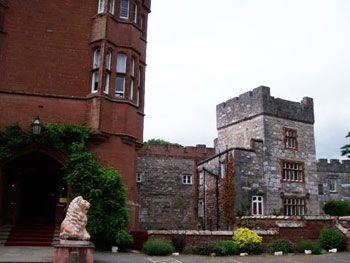 Caernarfon was once a motte and bailey castle (castle on a mound surrounded by a courtyard). This mound still resides within the courtyard as a dais made of Welsh slate, and was the scene of two Princes of Wales getting their official titles, that being Edward VIII in 1911 and then Prince Charles in 1969. The northeast tower has an extensive exhibit of those two investitures, including Charles’ BBC telecast. Charles immediately walked through the Queen’s Gate to greet his subjects, something which I got to do, as a special balcony still remains for photo opps.
Caernarfon was once a motte and bailey castle (castle on a mound surrounded by a courtyard). This mound still resides within the courtyard as a dais made of Welsh slate, and was the scene of two Princes of Wales getting their official titles, that being Edward VIII in 1911 and then Prince Charles in 1969. The northeast tower has an extensive exhibit of those two investitures, including Charles’ BBC telecast. Charles immediately walked through the Queen’s Gate to greet his subjects, something which I got to do, as a special balcony still remains for photo opps.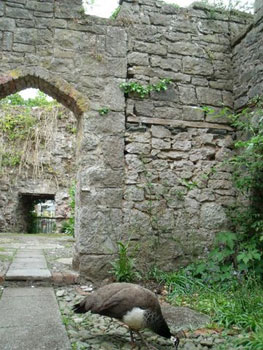 While the Vale of Clwyd is at the bottom of some incredible footpaths with steep angles going up hundreds of feet in the Clwydian Hills that’ll challenge any hiker, the town of Ruthin (an hour’s drive from Manchester) has a castle with the same namesake that’s located just above the base of the valley. It sits on grounds once allegedly housing a fort where King Arthur kept a little “love nest” for one of his mistresses dating before the Norman conquest, but it’s confirmed date for a standing edifice dates back to 1277, when Edward I secured it for his kingdom against the rebellious Welsh.
While the Vale of Clwyd is at the bottom of some incredible footpaths with steep angles going up hundreds of feet in the Clwydian Hills that’ll challenge any hiker, the town of Ruthin (an hour’s drive from Manchester) has a castle with the same namesake that’s located just above the base of the valley. It sits on grounds once allegedly housing a fort where King Arthur kept a little “love nest” for one of his mistresses dating before the Norman conquest, but it’s confirmed date for a standing edifice dates back to 1277, when Edward I secured it for his kingdom against the rebellious Welsh.